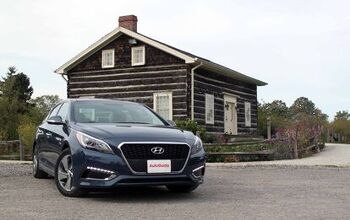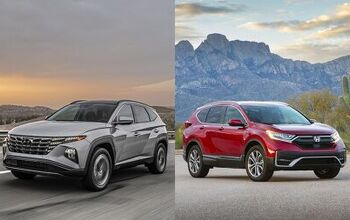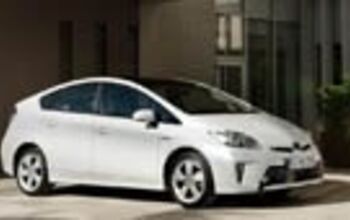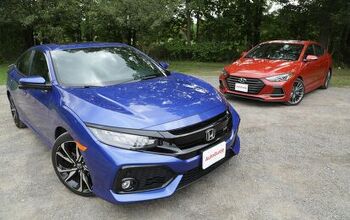Honda Civic Hybrid vs Hyundai Elantra Hybrid Comparison

Co-Written by Mike Schlee
It wasn’t the most surprising outcome.
We knew going into our massive, entire-class compact car comparison that the Honda Civic had a good chance of winning. The Big H has had compact cars figured out for a while, and the 2025 addition of the hybrid powertrain added incredible fuel economy to the equation.
But it was the other Big H that surprised us. The Hyundai Elantra is a fine enough daily driver, yet in its own hybrid form, it came up second—and even beat the Civic in a few key areas. We decided to take a closer look at the pair and see what made both of them so darned good.
Honda Civic Hybrid vs Hyundai Elantra Hybrid Quick Take
Both the Honda Civic and Hyundai Elantra now come in hybrid form, and they’re two of the best compact cars on sale today. The Honda has a higher price tag, but how much that’s worth it depends on what you value in your small car.
What’s New for 2025:
For the 2025 model year, it’s the Honda Civic that sees the biggest changes. The iconic compact car is refreshed this year, with an updated look up front as well as new taillights and some new colors. Of course, the biggest news is the addition of hybrid models, like the one we have on hand for this comparison.
The Hyundai Elantra Hybrid soldiers into the 2025 model year virtually unchanged. There is a SEL Sport HEV trim and a few other minor changes here and there.
Exterior Style:
You’d never know it by looking at them, but the Civic is the smaller car here. Okay, we’re talking barely smaller: an inch shorter at 184.4 in (4,694 millimeters) long, and an inch narrower (70.9 in / 1,800 mm). The Civic looks big, with its upright face and large, glassy greenhouse. The ’25 tweaks are subtle, limited to some body-color bits around the grille, a new lower bumper, and different wheel designs. The most daring part of the design is the little kink in the rear window—and that’s okay, because the handsome Civic is aging gracefully.
The Elantra is a bit more divisive. We appreciate that low nose, and the headlights that came in for the facelift last year give it a less surprised look. The Elantra got on the full-width taillight wagon earlier than most, so no complaints there. Same with the wheel design; a typical Hyundai strength, these days. It’s the fractal bodywork: Hyundai took a big swing, and while we appreciate that daring, the Elantra’s overall design has aged quickly.
2025 Honda Civic Sport Touring Sedan: All the Details
Powertrain and Fuel Economy:
We were pleasantly surprised when Honda dropped the Accord’s hybrid setup into the Civic. Sure, it’s very slightly down on power, but 200 horsepower and 232 pound-feet of torque make this thing stronger than the Civic Si. The electric assist only improves the Civic’s power delivery, giving it the responses (and power) of a larger-displacement engine. That makes it easy and predictable to operate. Honda’s electronic CVT does a good job of putting power down while keeping revs at a minimum. Better still, this package is good for a full 50 mpg (4.7 L/100 km) in the city.
The Elantra can’t match the power of the Civic, what with only a 1.6-liter engine. Total system power is just 139 horsepower. Being lighter and blessed with a still-plentiful 195 lb-ft, the Elantra nonetheless is more than up to the task of daily driving. With a six-speed dual-clutch transmission instead of the typical CVT, the Elantra makes progress in a very grown-up way. It also has the fuel economy advantage, at least officially: while it averages over 50 mpg (4.7 L/100 km), in a short real-world loop during our mega comparison, both vehicles tied at 52 mpg (4.5 L/100 km).
2025 Hyundai Elantra Hybrid: All the Details
Handling and Drivability:
Both of these cars have sportier variants that we rate quite highly. Does some of that magic sprinkle down into these regular models, then?
Well, sort of. The Civic does a better job here: there’s a consistency to its feedback and responses that makes it the more enjoyable car. We mean that for everyday driving, too: the Civic’s steering is both cleaner and has better weighting, making it more predictable. Those wanting a sportier sedan can always opt for the Si and its manual transmission, but even the Sport Touring is reasonably fun to fling down a backroad, with little body lean. The brake pedal is also firm and progressive.
It’s almost impressive how un-sporty the Elantra is, if only to highlight the broad capabilities of the platform. The Hyundai pitches and leans through corners, and its relatively small wheels and tires give up far earlier than those of the Civic. There’s very little feedback at the helm, either. The Elantra feels positively laidback, and it expects the same attitude from its driver.
Ride Quality and Comfort:
In terms of comfort, the Civic is the easy winner. Although the Elantra does have a comfortable front seat, it lacks a bit of headroom and can’t match the Civic’s soft, squishy yet supportive seating surface.
The rear seat is another instance of numbers can be deceiving. On paper, it looks like the Elantra should be more spacious since it offers more headroom and legroom. Yet, in real-world testing, we find the Civic rear bench the better place to be. The headroom in the Elantra feels a bit tighter and the sloped roofline means passengers are looking at more headliner when attempting to peer out the window compared to the Civic.
Regardless of which car is chosen, at this trim level they have outboard heated rear seats. Continuing further back, the Civic’s trunk is larger, squarer, and has a more rectangular, better opening.
Interior Style and Quality:
If you’re looking for an upscale cabin, the pick of these two is… the Mazda3. In all seriousness, the latest Civic’s cabin comes close to the bar-setting Mazda, with a clean, classy look that’s also easy to use. Material quality is uniformly high, and we appreciate Honda’s smart use of textures. Is there piano black? Yes. Is it somewhere you’re likely to be touching often? Nope. In that typical Honda way, it all feels solidly put together too.
As is the case with its exterior, the Elantra cabin makes some big stylistic swings. We generally appreciate the interior moves more: not everyone likes that enormous grab bar on the passenger’s side, but at least it stands out. Speaking of which, what other cabin—at any price—does the asymmetric color-coding like the Elantra? The two-tone look gives a distinct cockpit vibe for the driver, and we like that. Material quality isn’t quite at Honda levels: bits like the faux-wool look nice but feel scratchy, and hard plastics show up on the door panels. Considering the price gap, however, the Elantra makes a very good case for itself.
Tech and Safety:
The Elantra is the better equipped of the two vehicles, with things like ventilated front seats, a 360 camera, and a larger, more configurable infotainment system. The Civic does offer a power passenger seat though, and wireless Apple CarPlay or Android Auto. Yes, the Elantra still lacks that feature, and what’s worse, to hook up those systems a USB cord is still required and not a modern USB-c, but the bulkier USB-a.
With the refresh, the Civic now sports Honda’s most modern infotainment set-up, but still looks old in terms of hardware and software. The system and set-up in the Elantra just feels more modern and offers some great features like the customizable, split screen function. There’re also more hard button shortcuts in the Elantra and we found it easier to customize preferred settings in the Hyundai, especially radio presets.
A special shoutout must be made to both Honda and Hyundai for having proper physical buttons and dials to control the climate settings. Both are simple clean designs and big wins in today’s overcomplication of HVAC controls.
Value Dollars and Sense:
At an as tested price of $30,995 including destination charges, the Elantra Hybrid Limited undercuts the Civic Hybrid Touring by just under $2,500. In Canada, the gap widens further with the Elantra Hybrid costing $6,300 less after destination charges.
The leads to the age-old question of whether the Civic is worth that premium. The powertrain in the Honda is more robust, the driving experience is a bit more refined, comfort has an edge, and so on and so on. But that price premium is something any potential shopper needs to consider.
Final Thoughts: Honda Civic Hybrid vs Hyundai Elantra Hybrid Comparison
At the end of the day, yes, the Civic still remains our cost-no-object choice. But that’s the thing: plenty of folks shopping in this category are very much looking at price. With a much lower sticker and better financing deals to be had, the Elantra hybrid makes a lot of sense. It’s the diet Civic, providing most of the experience without as much pain to the wallet.
Become an AutoGuide insider. Get the latest from the automotive world first by subscribing to our newsletter here.
Category | 2025 Honda Civic Sport Touring | 2025 Hyundai Elantra Hybrid Limited |
|---|---|---|
Powertrain | 9 / 10 | 8 / 10 |
Efficiency | 9 / 10 | 10 / 10 |
Handling and Drivability | 8 / 10 | 6 / 10 |
Passenger Comfort | 8 / 10 | 8 / 10 |
Ride Quality | 4 / 5 | 4 / 5 |
Exterior Style | 4 / 5 | 3 / 5 |
Interior Style and Quality | 8 / 10 | 8 / 10 |
Infotainment | 7 / 10 | 8 / 10 |
Cargo Capacity and Towing | 4 / 5 | 4 / 5 |
Safety | 4 / 5 | 4 / 5 |
Value | 7 / 10 | 9 / 10 |
Emotional Appeal | 8 / 10 | 7 / 10 |
TOTAL | 80 / 100 | 79 / 100 |
Specifications | ||
|---|---|---|
| Honda Civic Hybrid | Hyundai Elantra Hybrid |
Engine/Motor | 2.0-liter four-cylinder hybrid | 1.6-liter four-cylinder hybrid |
Output: | 200 hp, N/A | 139 hp, 195 lb-ft |
Drivetrain: | FWD | FWD |
Transmission: | eCVT | 6DCT |
Fuel Economy USA (city/hwy): | 50 mpg / 47 mpg | 49 mpg / 52 mpg |
Fuel Economy Canada (city/hwy): | 4.7 L/100 km / 5.1 L/100 km | 4.8 L/100 km / 4.5 L/100 km |
Starting Price USA | $25,400 | $23,320 |
Starting Price Canada | $29,670 | $24,424 |
As Tested Price USA | $33,555 | $30,995 |
As Tested Price Canada | $39,230 | $32,924 |

Kyle began his automotive obsession before he even started school, courtesy of a remote control Porsche and various LEGO sets. He later studied advertising and graphic design at Humber College, which led him to writing about cars (both real and digital). He is now a proud member of the Automobile Journalists Association of Canada (AJAC), where he was the Journalist of the Year runner-up for 2021.
More by Kyle Patrick










































Comments
Join the conversation
Currently shopping compact cars. SHARPLY disagree with your view of the Civic's interior. It is SPARTAN in some ways, and unforgivably so given the higher price tag (especially in Canada). Shame on Honda for providing NO driver memory seat, lumbar adjust, front pass seat height adjust, rear HVAC vents nor rear power (USB) ports. The ventilated seats on the Elantra is a BIG deal for those living in warmer climates. And the claim that the Honda's interior materials are better than the Elantra's is just, well, WRONG. Sure the Honda handles a bit better, but as daily driver the Civic interior falls well short.
I don't think Elantra has 360 camera like the article says in any trim. I agree with last comment. Ventilated seats are a big win in Elantra's favor.